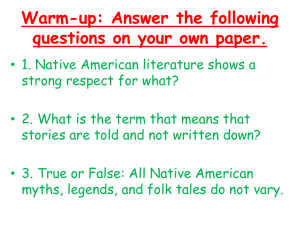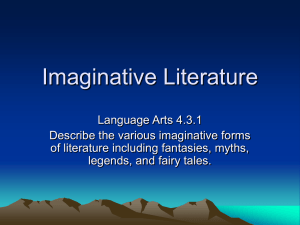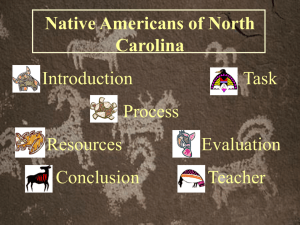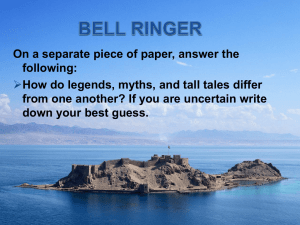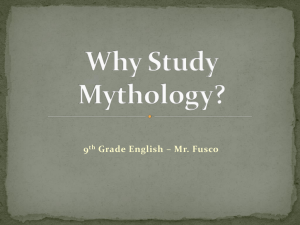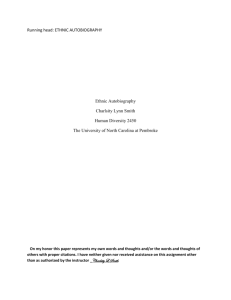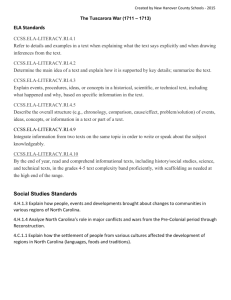Fourth Grader`s Guide to the Native Americans of North Carolina Next
advertisement
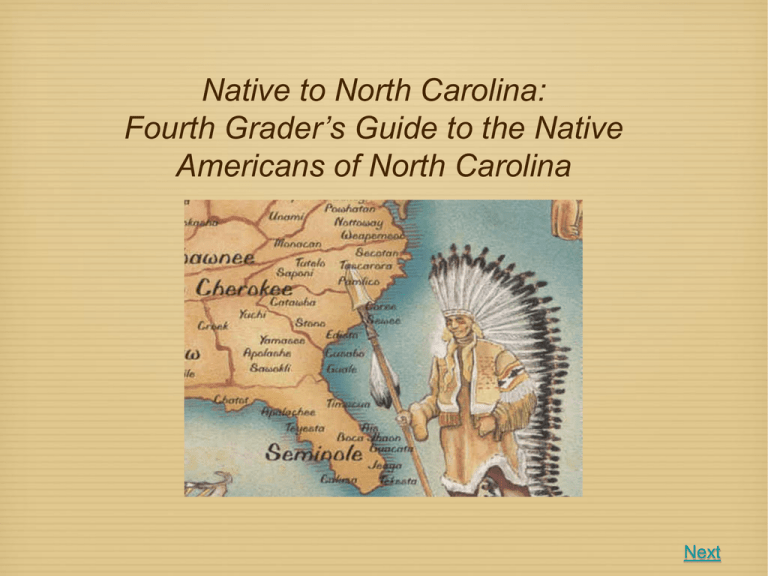
Native to North Carolina: Fourth Grader’s Guide to the Native Americans of North Carolina Next Table of Contents Slide 3: Introduction: North Carolina Natives Past Slide 4: Major Language Groups Slide 5: Iroquian Slide 6: Siouan Slide 7: Algonkian Slide 8: Beadwork Activity Slide 9: Myths and Legends Slide 10: Myths and Legends Rubric Slide 11: Books for Further Learning Slide 12: Teacher Information Slide 13: Modifications and Objectives Slide 14: Sites Used Next Introduction: North Carolina Natives Past Hi kids! My name is Ashwin. It means strong horse in my native language. I will be your guide. Today we are going to learn about North Carolina but we are going to focus on the original people, the Native Americans. Throughout this presentation you will have the opportunity to explore each subject in more detail by clicking the hyperlinks. The hyperlinks will be a picture and will take you to a website with more information on that particular topic. At the end, there will be a fun activity and a reflection. Enjoy! Go back to table of contents Next Major Language Groups There were three major languages spoken before the European settlers arrived. And with those three groups, there were different tribes within each group. The table below gives a few examples. Languages Native means one of the first people to live in a land Tribes Go back to table of contents Iroquoian Siouan Algonkian Cherokee Tuscarora Meherrin Catawba Saura Occaneechi Waccamaw Tutelo Secotan Croatan Roanoac Chowan Neusioc Next Iroquoian Cherokee Gourd Mask When thinking of Native Americans, the most recognized group comes from the Iroquoian language group. The Cherokee and the Tuscarora were the most famous. How were the two similar? How were they different? Click the pictures to explore about the groups further. Remember to take notes throughout the presentation. They may help you with an activity later. Focus on topics such as clothing, food, housing, transportation, and family life. Go back to table of contents Tuscarora Dancer Next The Siouan tribes such as the Catawba and the Tutelo lived in the piedmont and southern coastal plain areas. What are some ideal crops they grew? What did the kids do for fun? Remember, the pictures take you to another world so please explore! Siouan Did you know that Native Americans invented lacrosse? They originally called it Indian Stickball. What did you discover about the game? Catawba Pottery Further Exploration of Southwest Native American Tribes Go back to table of contents Next Algonkian Lumbee (Algonkian)Je welry Did you know that nation is similar to the word tribe? Nation means a group of people sharing the same ways of life. The Algonkian peoples lived along the Atlantic Ocean and Cape Fear River Basin. Some well known tribes were the Croatoans and the Chowans. However, they were some of the first tribes to die off. Many of them combined with other groups to form the Lumbee group. How are the Lumbee different from the other groups? Why is the word Croatoan famous? Click the picture to learn more. Go back to table of contents Next Beadwork Activity WOW!!! You guys have sure worked hard. Take a break with a fun activity. Just give me a click to create your own Native American artwork! Don’t forget to come back though! We have a few more activities. Go back to table of contents Next Myths and legends are a huge part of Native American culture. They help explain how normal things such as fire came to be. They often include animals in their storytelling. Myths and Legends Click the picture of the wolf to take you to a website and choose one of the myths or legends. Once you finish reading, complete a journal entry in the first person talking about your legend. Make sure you get into character and include emotions, feelings, and thoughts. Once you are finished with that, illustrate a scene from your legend or myth on a blank piece of paper. Be sure to include details from the presentation from the different language groups. Go back to table of contents Next Myths and Legends Rubric 3-Excellent Creativity 2-Good Work 1-Needs Improvement No use of color. Illustration Uses color and imagination. Uses some color. Illustration is completely unrelated to journal Illustration is related to journal semi related to journal entry. entry and text. Journal entry entry and story. Journal entry Journal entry shows some shows no understanding of shows understanding of text. signs of understanding of text. text. Incorporates Learned Material Uses at least 5 or more examples of Native American lifestyles in journal entry and at least two examples in illustration. Uses at least 3 or more examples of Native American lifestyles in journal entry and at least one example in illustration. Uses at least 1 example of Native American lifestyle in journal entry. No examples in illustration. Follows Directions Follows all directions and includes first person perspective. Has original opening. Follows most directions. May deviate from first person perspective a bit. Does not follow many of the directions. Deviates from first person the whole entry. Go back to table of contents Next Books for Further Learning Go back to table of contents Next Teacher Information This presentation is designed for fourth grade students as an introduction into Native Americans and is more of a self guided assignment. It introduces a few of the more well known Native American nations and allows the students to learn at their own pace while learning to navigate through websites for pertinent information. The first activity is more of a mindless mental break to allow the students to be creative. The second activity challenges the student to apply what they have learned in a meaningful manner in both journal entry and illustration. The final product could in theory be a classroom book with all illustrations and stories laminated into one book. Go back to table of contents Since this is an introductory lesson it could begin with a general discussion with what the students know of Native Americans, particularly with ones who are aboriginal to the North Carolina area itself. Next Modifications and Objectives Modifications: This is more of a self paced presentation however, for those students who are ESL or have a more difficult time with reading comprehension, modifications can be made. This presentation could span two or more class periods. If time is a constraint, partnering up could be another option. Also, using one of the related books as opposed to picking their own myth or legend can be used as a classroom wide activity. SCOS Social Studies Objective 2.01 Locate and describe American Indians in North Carolina, past and present. SCOS English and Language Arts Objective 2.06 Summarize major points from fiction and nonfiction text(s) to clarify and retain information and ideas. Objective 4.07 Compose fiction, nonfiction, poetry, and drama using self-selected and assigned topics and forms (e.g., personal and imaginative narratives, research reports, diaries, journals, logs, rules, instructions). Go back to table of contents Next Sites Used Facts for Kids: Cherokee Indians Facts for Kids: Tuscarora Indians Facts for Kids: Catawba Indians Facts for Kids: Lumbee Indians Native American Technology and Art Oban’s Myths, Legends, and Fables Learn About Native Americans Back to table of contents


